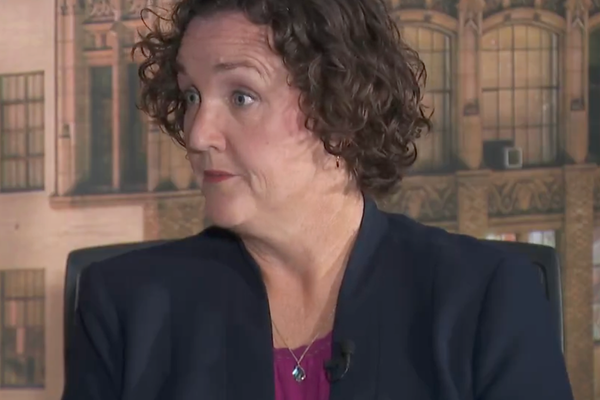NEW YORK — Given the breadth of basketball talent to come out of New York City, the most from anywhere since James Naismith repurposed his peach baskets, it is, in many ways, a travesty that universities within the five boroughs have just one NCAA title.
The individual college champions, whether Kareem Abdul-Jabbar, Bob Cousy or Joakim Noah, all won outside of NYC, leaving CCNY with the lone title from its 1950 run. Programs here failed to gain traction after the wave of point-shaving scandals in the early ‘50s, leaving us to get overexcited about short-lived uprisings from St. John’s or, if you count neighboring North Jersey, P.J. Carlesimo’s Seton Hall Pirates.
But that’s kind of what this story is about. Last week was the 65th anniversary of one of the greatest games in NCAA Finals history, a matchup between UNC and Kansas that’s relevant today because the programs may stage a rematch for this year’s title.
UNC won that 1957 game in triple overtime by beating Wilt Chamberlain, using a roster of imported New Yorkers coaxed to Chapel Hill by Frank McGuire, a legendary coach and son of an NYPD officer.
Players 1 through 7 in UNC’s rotation hailed from New York, prompting publications like the New York Times to label McGuire’s recruiting system a “reverse underground railroad.”
“One paper had a cartoon with the South Building in Chapel Hill and the IRT Subway coming right in front of it, with a bunch of tall guys coming out,” recalled Joe Quigg, the team’s center.
The New York Daily News caught up with two players on UNC’s first championship squad, both native New Yorkers who arrived in Chapel Hill nearly 70 years ago and still reside in North Carolina.
Lennie Rosenbluth, now 89, was the team’s star, a Jewish forward from the Bronx who beat out Chamberlain for the NCAA’s Player of the Year in 1957. Rosenbluth remembers McGuire quizzing the players before tip-off, one by one, “Are you afraid of Wilt?”
“Of course we said, ‘No,’ ” Rosenbluth said.
McGuire then decided to send a message by using UNC’s shortest player, 5-11 Tommy Kearns, to face Chamberlain in the opening tipoff. Kearns didn’t bother jumping and immediately sprinted back to set up the defense, preventing Chamberlain from a quick transition bucket that would’ve fired up the pro-Kansas crowd.
The strange tactic worked. Kansas was stopped on the first possession, and UNC created a defensive wall around Chamberlain, whether he was on or off the ball. The Tar Heels limited Chamberlain to 23 points on 6-of-13 shooting, the only time he failed to score at least 30 in the tournament.
“Our whole defense was surround Chamberlain and hope the rest of the team doesn’t start hitting their shots,” Rosenbluth said. “And that’s what we did.”
Rosenbluth finished with 20 points but fouled out in the third OT, giving the runway to Quigg to become the hero. With about six seconds remaining, Quigg, a Brooklyn product who used to read the Daily News when it was 3 cents per copy, was fouled on a drive with UNC trailing by 1. He was brashly confident — “I told Coach, ‘I’m going to make those free throws” — and nailed the clutch go-ahead shots. Quigg knocked away Kansas’ pass to Chamberlain on the ensuing possession, completing a perfect season for UNC’s first championship.
The dynasty at Chapel Hill was started by New Yorkers.
“32-0,” Quigg said.
Quigg never played another official basketball game. He injured his leg during an intrasquad scrimmage with UNC the following season, and his potential was still alluring enough for the Knicks to draft him 11th overall in 1958.
Quigg received a $6,500 salary for his lone season with the Knicks but never played because of the leg injury.
“I just couldn’t run,” the 85-year-old said.
Quigg transitioned quickly to dental school, attacking cavities instead of rebounds. He still practices in Fayetteville, N.C., albeit in a limited capacity after retiring over 20 years ago. Quigg’s hoping for a UNC-Kansas rematch, but doesn’t want to think too far ahead with Duke as the semifinal opponent Saturday (Kansas faces Villanova on the other side of the bracket).
“I’m going to be watching right here with my wife. I need somebody to yell at when they screw up,” Quigg laughed.
Rosenbluth was drafted sixth overall by the Philadelphia Warriors in 1957 but called it a bad fit. He played the same position as the Warriors’ star, Paul Arizin, and managed two nondescript seasons in the NBA.
Rosenbluth became a teacher and coach at a high school in Coral Gables, Fla., never once returning to his old neighborhood in the Bronx. He moved back to Chapel Hill and is trying to rehabilitate his ailing legs to again walk and attend games at the Dean Smith Center. Before Chamberlain died in 1999, Rosenbluth and the NBA Hall of Famer would occasionally meet at a Boca Raton restaurant and discuss that epic game in 1957.
Sixty-five years later, it remains one of New York City basketball’s greatest achievements ... with an assist from the state of North Carolina.







